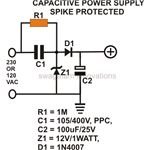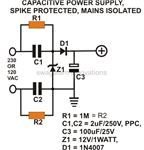electronicsIUST
Member level 3

Hi, Can anyone say what is difference between these circuits?! Both of them are capacitor power supply. What is better or there isn't significant difference?!




Follow along with the video below to see how to install our site as a web app on your home screen.
Note: This feature may not be available in some browsers.






Hi,
First: None of those two supplies is isolated - although they say so.
Touching any pin/signal in this circuit is dangerous!
***
To your question:
The above is connecting GND directely to mains input. While the other is some kind of symmetric regarding input impedance of both wires with respect to system GND.
Especially the voltage rating of the capacitors in the lower circuit is something like "ideal".
It may work in a closed plastic box without any connection (or other conductive piece) to the outside.
None of both has any protectin against mains transiet voltages.
And none has any level of safety.
Klaus


Hi,
functional: nothing
safety: horrible
Klaus




Hi,
functional: nothing
safety: horrible
Klaus


It should be clarified that the "ground" symbol designates an internal common node rather than ground. It's a hazardous contact voltage and must be strictly isolated against instrument chassis and any accessible metal part.
Under this prerequisite, both circuits can be used with phase-to-phase supply as well.


This is starting to get rather bizarre. Do you really have an idea of what single phase and 3-phase circuits are all about?
In a 3-phase circuit, the three phases carry the voltage at 120 degrees apart - when you add all 3 phases together at any point in time you get zero voltage - which is what the neutral line carries.
In a single phase circuit the voltage occurs between the phase and the neutral lines as a sine wave. In this case there is no other phase to use as a reference for the 'phase' of the sine wave but the voltage will go from the largest positive value, through zero to the largest negative value and back again.
If you look at two phases, they will be 120 degrees apart. That means the voltage between them will be all over the place and will certainly not be sinusoidal. That means there will be all sorts of higher frequencies present and makes for a far more complex rectifier filter circuit. (I know there are 2-phase systems where the voltages are 90 degrees apart but these require different generation techniques and the underlying issue still remains.)
This is one of the reasons why two-phase power systems are very rare with single phase and 3-phase circuits being wide spread.
Also, if you have 3-phase power into your bulding, you will not be making others happy if you produce an unbalanced load on 2 of the phases.
Susan

The answer is that you should make no assumptions about power supply earthing and particularly neutral potential in a capacitive power supply. If the ground symbol in your schematic means an external connection (e.g. neutral), you must not use the second circuit and can use the first only under very restricted conditions.But I should consider what will happen if someone connect two phases to the input by mistake!

If you look at two phases, they will be 120 degrees apart. That means the voltage between them will be all over the place and will certainly not be sinusoidal. That means there will be all sorts of higher frequencies present and makes for a far more complex rectifier filter circuit.
Susan
... But I should consider what will happen if someone connect two phases to the input by mistake!

Lets say that one phase is 'sin(x)' and the other is 'sin(x+120)'. Given the difference of 2 sines is 'sin(u)-sin(v)= 2sin((u-v)/2)cos((u+v)/))' thenWhy should be the voltage between two phases (the delta voltage; in a three-phase system) non-sinusoidal and contain "all sorts of higher frequences"?

Lets say that one phase is 'sin(x)' and the other is 'sin(x+120)'. Given the difference of 2 sines is 'sin(u)-sin(v)= 2sin((u-v)/2)cos((u+v)/))' then
sin(x)-sin(x+120)=2sin((x-x-120)/2)cos(x+x+120)/2)
= 2sin(-60)cos(x+60)
=-sqrt(3)cos(x+60)
I stand corrected.
And of course I shold have realised that the 3rd phase (which is sinusoidal as well) balances out the other two. Sigh - grey moment!
Susan